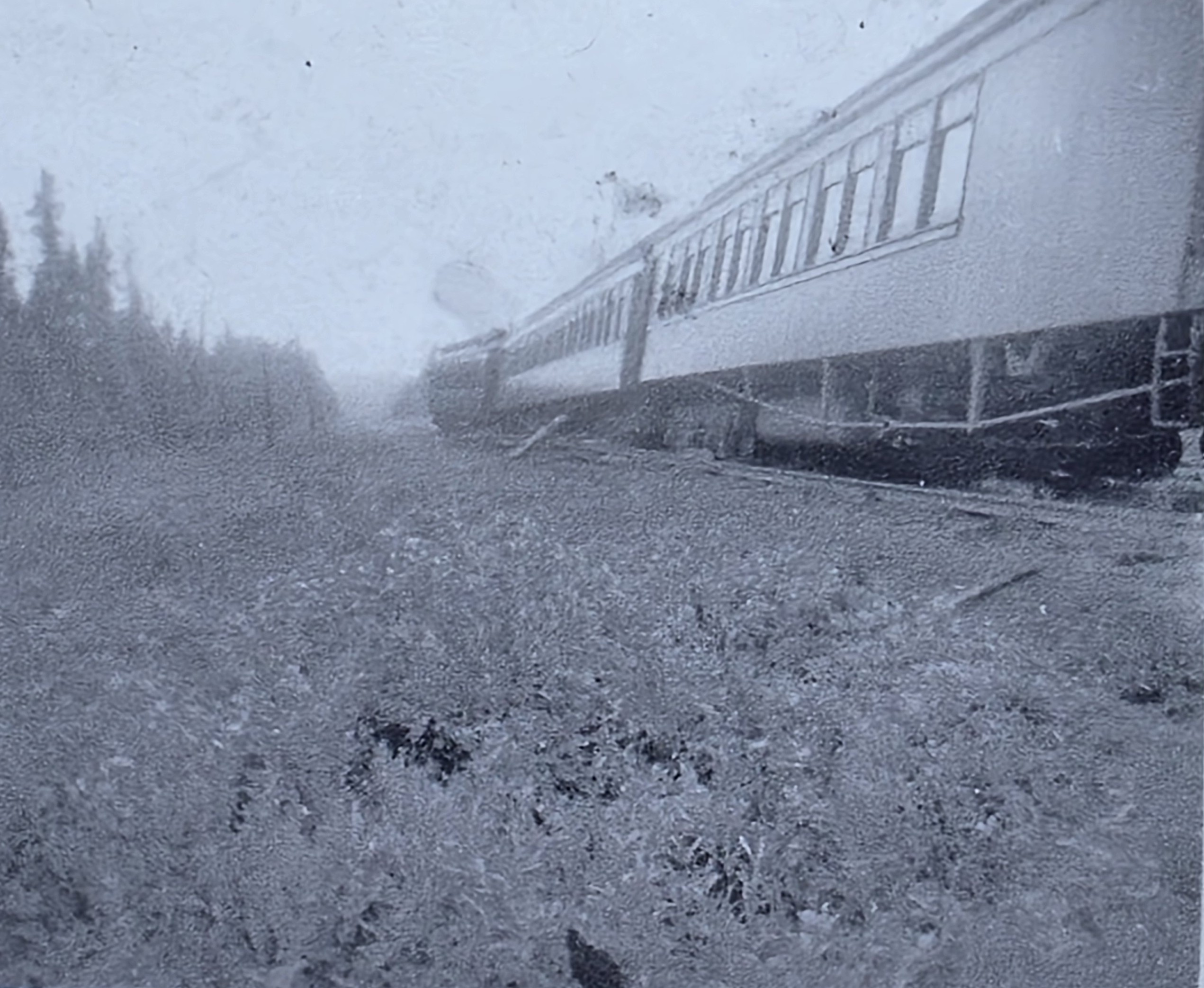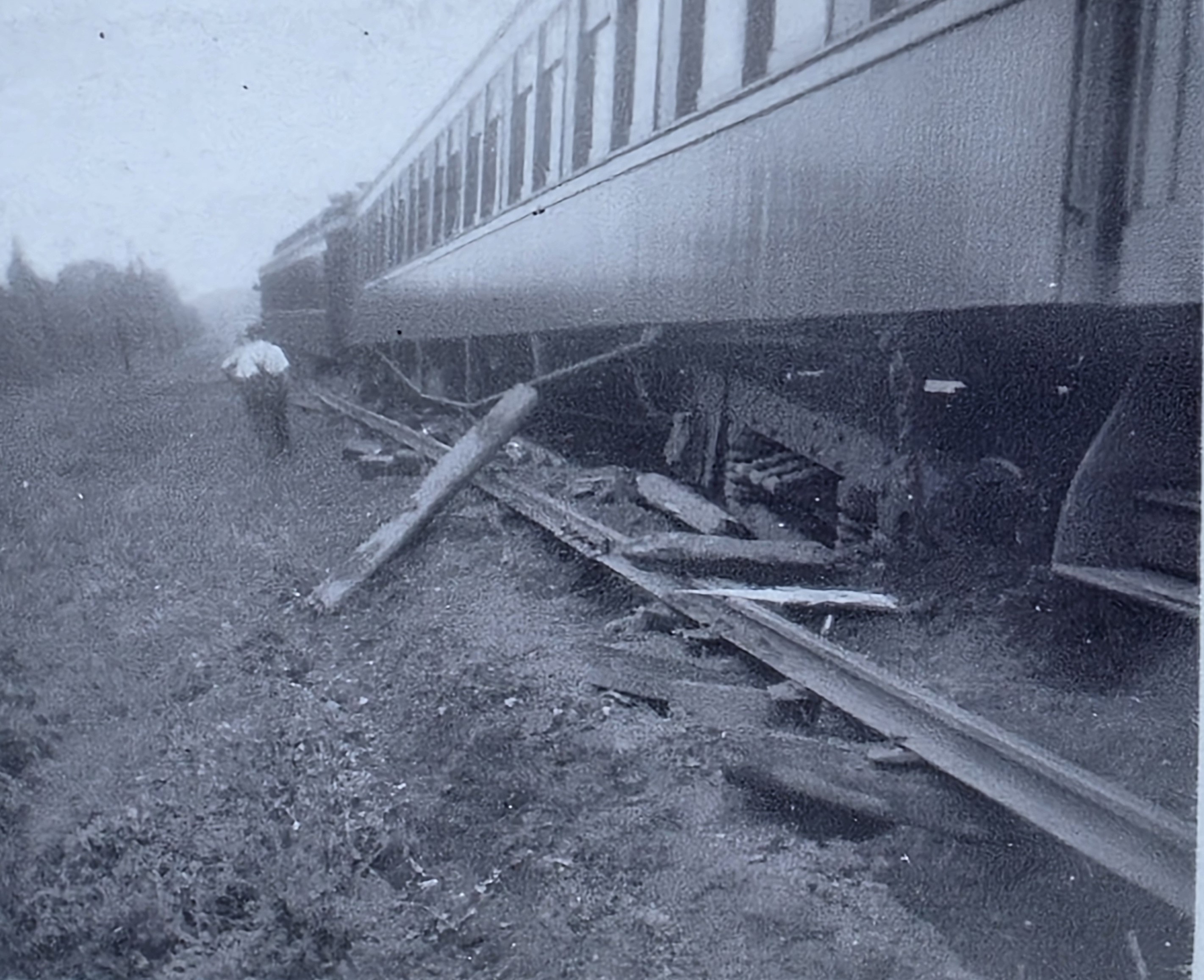Details of Railway Accidents in the Ottawa Area

1948, 19 August - Four passenger cars derailed at a washout at Adams Crossing, CPR Maniwaki sub. no injuries

| From the Ottawa Citizen Thursday 19 August 1948 CPR Train Derailed The Gatineau morning train of the Canadian Pacific Railway due to arrive at Ottawa at 10.45 o'clock, railway time from Maniwaki, was delayed because of a derailment north of Kazabazua in which none of the passengers or crew was injured, it was reported. Following a heavy rain for some hours last night, the train of five coaches is believed to have run into a washout, the scene being at Adams Crossing, which is four miles north of Kazabazua. There were approximately 35 passengers but they escaped with a shaking up because the coaches remained upright after leaving the rails. The locomotive is understood to have remained on the track, the train having been travelling at a slow speed before the time of the accident. Word was sent into Kazabazua and taxicabs were rushed from the Kazabazua Hotel to bring the passengers into the village where they were met by a special train from Ottawa to transport them the balance of the trip to the city. The special left Kazabazua at 11.30 o'clock standard time, which is 12.30 daylight saving time. Three Hours Late The special train reached Ottawa around 2.30 o'clock this afternoon, almost three hours after the scheduled hour of arrival. A highway bus was despatched from Ottawa for the 55-mile drive to Kazabazua but it had not been seen there at noon and it was expected that it would not be needed fcr the transportation of any persons, due to the use of the special train. The railway at Adams Crossing continued to be blocked but a crew of maintenance-of-way employes and others from an auxiliary emergency train were soon put to work to repair the roadbed and clear the track. Mail which was being carried by the halted train did not get through but would be transported later in the day alcng with express shipments and baggage. There was some uncertainty at Kazabazua as to the number of cars which had left the track but the general report was that four cars had jumped the rails, leaving one on the track with the engine. Preliminary arrangements had been made for the providing of a mid-day meal for the temporarily-stranded passengers at the Kazabazua Hotel but the special train arrived to bring the people to Ottawa without further delay. The proprietor of the hotel. Hubert Pettapiece, happened, to be in Ottawa for the day. Numerous telephone calls were received at the Union Station regarding the welfare of the incoming passengers and their time of arrival here. There was the welcome assurance that no one had been hurt and that everybody was being taken care of by the CPR as speedily as possible. No estimate was available as to the extent of the damage to rolling stock but it was not believed to be extensive. The accident took place at Adams Crossing which is a short distance from McArthur siding and some distance south of Perras flag station. Gracefield is some 15 miles farther north. The train leaves early each morning from Maniwaki and normally reaches Kazabazua at 8.46 a.m. railway time. Ottawa Journal 19 August 1948 Gatineau Train Derailed. The CPR Gatineau train, due to arrive in Ottawa from Maniwaki this morning, was derailed at Adams Crossing, north of Kazabazua, as a result of a wash out after last night's heavy rains. None of the 35 passengers suffered more than a slight shaking up. The train was travelling slowly, and none of the cars overturned. The locomotive remained on the track. Taxis were sent out from Kazabazua to take the passengers to that town, where a special train took them to Ottawa. The regular train arrived in Ottawa at two p.m. more than two hours late. Bill McConnell writes (12/2018)
What caused the derailment of the coaches was a broken brace located towards the rear of the tender that hung down and split the switch points on the south end of the siding. The first coach derailed as did all of the coaches. The ties were pulled loose by the coach trucks and piled up in front the trucks. All coaches stayed upright and the locomotive remained on the tracks. In a conversation that my father and I had with the engineer, he said that he didn’t feel the added drag and by chance he looked back, saw the coaches fishtailing and stopped. The coaches were put back on rails by laying down temporary track under the coach and jacking the front wheels of each truck and sliding the rails under the front wheels then the work train engine would “inch” the truck onto the rails. It was an exceptionally slow process as each pull was only inches at a time followed by resetting of blocks. That evening, I was in the cab of the pulling engine talking to the engineer, MacPherson by name. He was explaining to me the function of the various engine controls when he momentarily moved the brake handle and the engine moved slightly as did the coach under which a number of men were working. The air was blue with the shouting from the startled men who could have been injured by the unexpected movement of the coach. Regarding the Citizen article, I suspect that the newspaper writer got half the story and made up the other half and what I have written above is the real story. First off, there are no streams crossing or near the tracks in that area that could cause a flood. It is the top of the grade north of Aylwin Station - dry sandy land. The only water at near track level in that area would have been a pothole body of water about 100 yards away from the RR near the Adams house. It is so small that one could throw a stone across it. No inlet and no outlet. The only crossings in that area was (and is) the one on the municipal road and one that we called "Moore’s crossing" which was S-W from the Adams house. I can’t recall any other derailment in that area |

Return to Main Page of Railway Accidents
Updated7 May 2025



